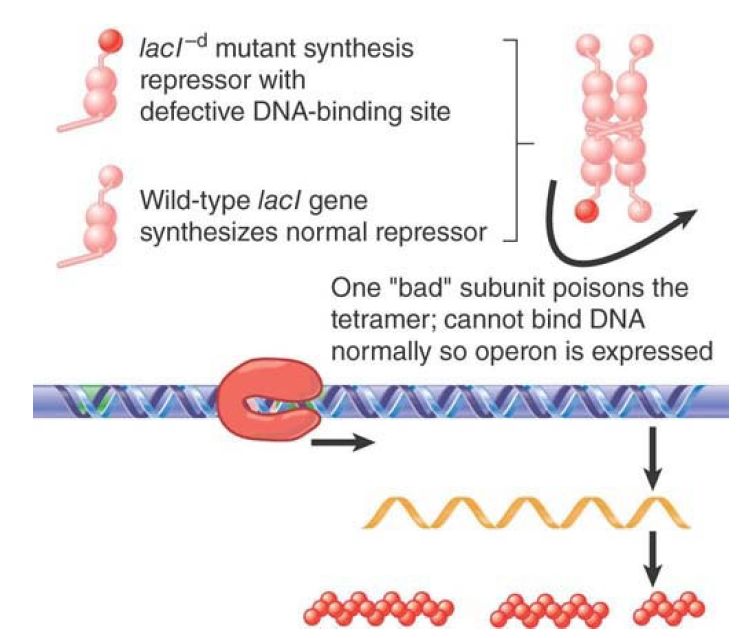


 النبات
النبات
 الحيوان
الحيوان
 الأحياء المجهرية
الأحياء المجهرية
 علم الأمراض
علم الأمراض
 التقانة الإحيائية
التقانة الإحيائية
 التقنية الحيوية المكروبية
التقنية الحيوية المكروبية
 التقنية الحياتية النانوية
التقنية الحياتية النانوية
 علم الأجنة
علم الأجنة
 الأحياء الجزيئي
الأحياء الجزيئي
 علم وظائف الأعضاء
علم وظائف الأعضاء
 الغدد
الغدد
 المضادات الحيوية
المضادات الحيوية|
Read More
Date: 7-5-2021
Date:
Date: 23-12-2015
|
trans-Acting Mutations Identify the Regulator Gene
KEY CONCEPTS
- Mutations in the lacI gene are trans-acting and affect expression of all lacZYA clusters in the bacterium.
- Mutations that eliminate lacI function cause constitutive expression and are recessive (lacI- ).
- Mutations in the DNA-binding site of the repressor are constitutive because the repressor cannot bind the operator.
- Mutations in the inducer-binding site of the repressor prevent it from being inactivated and cause uninducibility.
- When mutant and wild-type subunits are present, a single lacI-d mutant subunit can inactivate a tetramer whose other subunits are wild type.
- lacI-d mutations occur in the DNA-binding site. Their effect is explained by the fact that repressor activity requires all DNA-binding sites in the tetramer to be active.
Two types of constitutive mutations can be distinguished
genetically. Oc mutants are cis-dominant, whereas lacI- mutants are recessive. This means that the introduction of a normal lacI gene can restore control, even in the presence of a defective lacI gene. The lac repressor protein is diffusible; thus, the normal lacI gene can be placed on an independent molecule of DNA. Other lacI mutations can cause the operon to be uninducible (unable to be turned on, denoted lacIs ), similar to mutations in the promoter.
Constitutive transcription is caused by mutations of the lacI type, which are caused by loss of DNA-binding function (including deletions of the gene). When the repressor is inactive or absent, transcription of the lac operon can initiate at the lac operon promoter. FIGURE 1 shows that the lacI mutants express the structural genes all the time (constitutively), irrespective of whether the inducer is present or absent, because the repressor is inactive.
One important subset of lacI mutations (called lacI ) is localized in the DNA-binding site of the repressor. The lacI mutations abolish the ability to turn off the gene by damaging the site that the repressor uses to contact the operator. They are dominant mutations because a mixed tetramer with both normal and mutant repressor subunits cannot bind the operator (described shortly).

FIGURE 1. Mutations that inactivate the lacI gene cause the operon to be constitutively expressed, because the mutant repressor protein cannot bind to the operator.
Uninducible mutants are caused by mutations that abolish the ability of repressor to bind or to respond to the inducer. They are described as lacIs . The repressor is “locked in” to the active form that recognizes the operator and prevents transcription. These mutations identify the inducer-binding site and other positions involved in allosteric control of the DNA-binding site. The mutant repressor binds to all lac operators in the cell to prevent their transcription and cannot be removed from the operator, even if wild-type protein is present.
An important feature of the repressor protein is that it is multimeric. Repressor subunits associate at random in the cell to form the active tetramer. When two different alleles of the lacI gene are present, the subunits made by each can associate to form a heterotetramer, whose properties differ from those of either homotetramer. This type of interaction between subunits is a characteristic feature of multimeric proteins and is described as interallelic complementation.
Most lacI- mutations inactivate the repressor. Thus, these genes are recessive when coexpressed with the wild-type repressor, and the lac operon is normally regulated. Combinations of certain repressor mutants, however, display a form of interallelic complementation called negative complementation. As mentioned earlier, lacI-d mutations are dominant when paired with a wild-type allele. Such mutations are called dominant negative (illustrated in FIGURE 2). The reason for their behavior is that one mutant subunit in a tetramer can antagonize the function of the wild-type subunits, as discussed in the next section. The lacI-d mutation alone results in the production of a repressor that cannot bind the operator, and it is therefore constitutive like other lacI alleles.

FIGURE 2. A lacI-d mutant gene makes a monomer that has a damaged DNA binding (shown by the red circle). When it is present in the same cell as a wild-type gene, multimeric repressors are assembled at random from both types of subunits. It only requires one of the subunits of the multimer to be of the lacI type to block repressor function. This explains the dominant negative behavior of the lacI-d mutation.



|
|
|
|
دخلت غرفة فنسيت ماذا تريد من داخلها.. خبير يفسر الحالة
|
|
|
|
|
|
|
ثورة طبية.. ابتكار أصغر جهاز لتنظيم ضربات القلب في العالم
|
|
|
|
|
|
|
سماحة السيد الصافي يؤكد ضرورة تعريف المجتمعات بأهمية مبادئ أهل البيت (عليهم السلام) في إيجاد حلول للمشاكل الاجتماعية
|
|
|